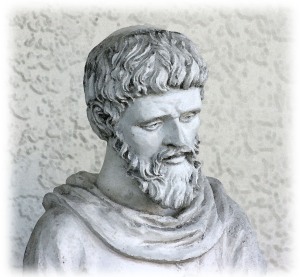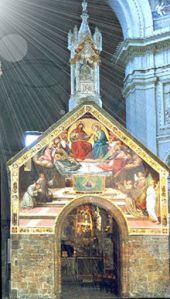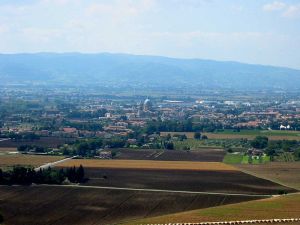
Saint Francis of Assisi (Giovanni Francesco di Bernardone; 1181/1182 – October 3, 1226)[2] was a Catholic deacon and preacher. He also was the founder of the Order of Friars Minor, more commonly known as the Franciscans. He is known as the patron saint of animals, the environment and one of the two patrons of Italy (with Catherine of Siena), and it is customary for Catholic churches to hold ceremonies blessing animals on his feast day of 4 October. The term Franciscan is most commonly used to refer to members of Catholic religious orders, founded by Saint Francis of Assisi. As well as Roman Catholic there are also small Old Catholic and Anglican Franciscan communities. It can also be applied to ideals he inspired in many movements in the modern age.
Thomas of Celano (Italian: Tommaso da Celano; c. 1200 – c. 1260-1270) was an Italian friar of the Franciscans (Order of Friars Minor), a poet, and the author of three hagiographies about Saint Francis of Assisi.
_____________________________________________________________
[youtube=http://www.youtube.com/watch?v=P2_GeQKqZ2E&feature=related]
_____________________________________________________________ This little church was given around 1208 to St. Francis by the Abbot of St. Benedict of Monte Subasio, on condition of making it the mother house of his religious family. It was in bad condition, laying abandoned in a wood of oak trees. He restored it with his own hands. Porziuncola, also called Portiuncula (in Latin) or Porzioncula, is a small church in the frazione of Santa Maria degli Angeli, situated about 4 kilometers from Assisi, Umbria (central Italy). It is the place from where the Franciscan movement started. The name Porziuncola (meaning “small portion of land”) was first mentioned in a document from 1045, now in the archives of the Cathedral of San Rufino, Assisi.
This little church was given around 1208 to St. Francis by the Abbot of St. Benedict of Monte Subasio, on condition of making it the mother house of his religious family. It was in bad condition, laying abandoned in a wood of oak trees. He restored it with his own hands. Porziuncola, also called Portiuncula (in Latin) or Porzioncula, is a small church in the frazione of Santa Maria degli Angeli, situated about 4 kilometers from Assisi, Umbria (central Italy). It is the place from where the Franciscan movement started. The name Porziuncola (meaning “small portion of land”) was first mentioned in a document from 1045, now in the archives of the Cathedral of San Rufino, Assisi.___________________________________________________________
[youtube=http://www.youtube.com/watch?v=SvPjdEOKsVY]
__________________________________________________________________
 Santa Maria degli Angeli is a frazione of the comune of Assisi in the Province of Perugia, Umbria, central Italy. It stands at an elevation of 218 metres above sea level. At the time of the Istat census of 2001 it had 6665 inhabitants,[1] and is located c. 4 km south from Assisi. The name of the city was used by the Spanish Franciscan missionaries as the name of Los Angeles, now one of the largest cities of the United States.
Santa Maria degli Angeli is a frazione of the comune of Assisi in the Province of Perugia, Umbria, central Italy. It stands at an elevation of 218 metres above sea level. At the time of the Istat census of 2001 it had 6665 inhabitants,[1] and is located c. 4 km south from Assisi. The name of the city was used by the Spanish Franciscan missionaries as the name of Los Angeles, now one of the largest cities of the United States.____________________________________________________________
 It is home to the Basilica of Santa Maria degli Angeli, which includes the Porziuncola, the most sacred place of the Franciscan Order of the Roman Catholic Church. St. Francis of Assisi himself died here. The Basilica of Santa Maria degli Angeli (Saint Mary of the Angels) is a church situated in the plain at the foot of the hill of Assisi, Italy, in the frazione of Santa Maria degli Angeli. The basilica was constructed between 1569 and 1679 enclosing the 9th century little church, the Porziuncola, the most sacred place for the Franciscans. It was here that the young Francis of Assisi understood his vocation and renounced the world in order to live in poverty among the poor and thus started the Franciscan movement.
It is home to the Basilica of Santa Maria degli Angeli, which includes the Porziuncola, the most sacred place of the Franciscan Order of the Roman Catholic Church. St. Francis of Assisi himself died here. The Basilica of Santa Maria degli Angeli (Saint Mary of the Angels) is a church situated in the plain at the foot of the hill of Assisi, Italy, in the frazione of Santa Maria degli Angeli. The basilica was constructed between 1569 and 1679 enclosing the 9th century little church, the Porziuncola, the most sacred place for the Franciscans. It was here that the young Francis of Assisi understood his vocation and renounced the world in order to live in poverty among the poor and thus started the Franciscan movement.The most prominent group is the Order of Friars Minor (commonly called simply the "Franciscans"). They seek to follow most directly the manner of life the Saint led. This Order—actually divided among three separate groups—is a mendicant religious order of men tracing their origin to Francis of Assisi. The three separate groups, each considered a religious order in its own right, are the Observants, most commonly simply called "Franciscan friars," the Capuchins, and the Conventual Franciscans. They all live according to a body of regulations known as "The Rule of St. Francis".
_____________________________________________________________
[youtube=http://www.youtube.com/watch?v=ZI1Gst7pEqc&feature=related]
__________________________________________________________________________________________________________________________

